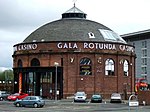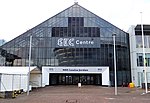Exhibition Centre railway station

Exhibition Centre railway station, previously called Finnieston (1979–1986) and Stobcross (1894–1959) due to its location in the Stobcross area of the city, is a railway station in Glasgow on the Argyle Line. It serves the OVO Hydro, the SEC Centre and the SEC Armadillo which are accessible by adjoining footbridge from an island platform. The station suffers badly from congestion at concerts as most of Greater Glasgow can be reached from the station. There is a siding adjacent to Platform 2, that can be used as a turnback siding for trains terminating at Anderston or Glasgow Central Low Level. The line is served by Class 318s and Class 320s. Ticket gates are in operation.
Excerpt from the Wikipedia article Exhibition Centre railway station (License: CC BY-SA 3.0, Authors, Images).Exhibition Centre railway station
Minerva Street, Glasgow Finnieston
Geographical coordinates (GPS) Address Nearby Places Show on map
Geographical coordinates (GPS)
| Latitude | Longitude |
|---|---|
| N 55.8611 ° | E -4.2828 ° |
Address
Minerva Street
Minerva Street
G3 8BY Glasgow, Finnieston
Scotland, United Kingdom
Open on Google Maps











